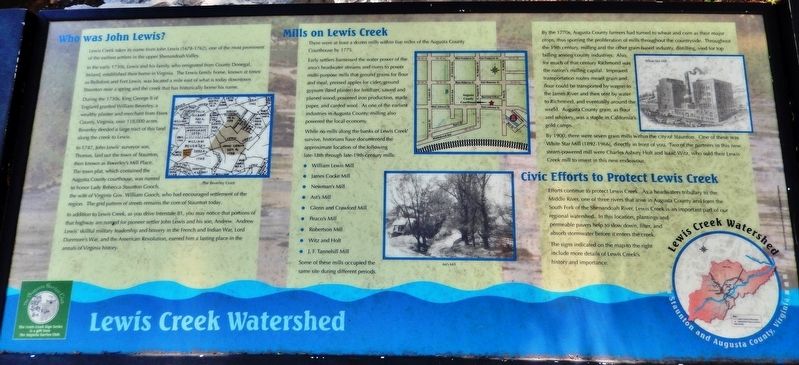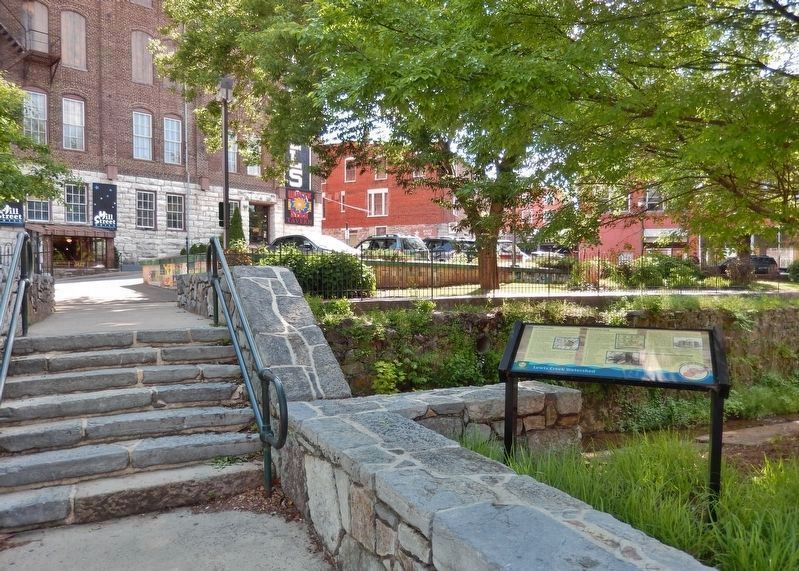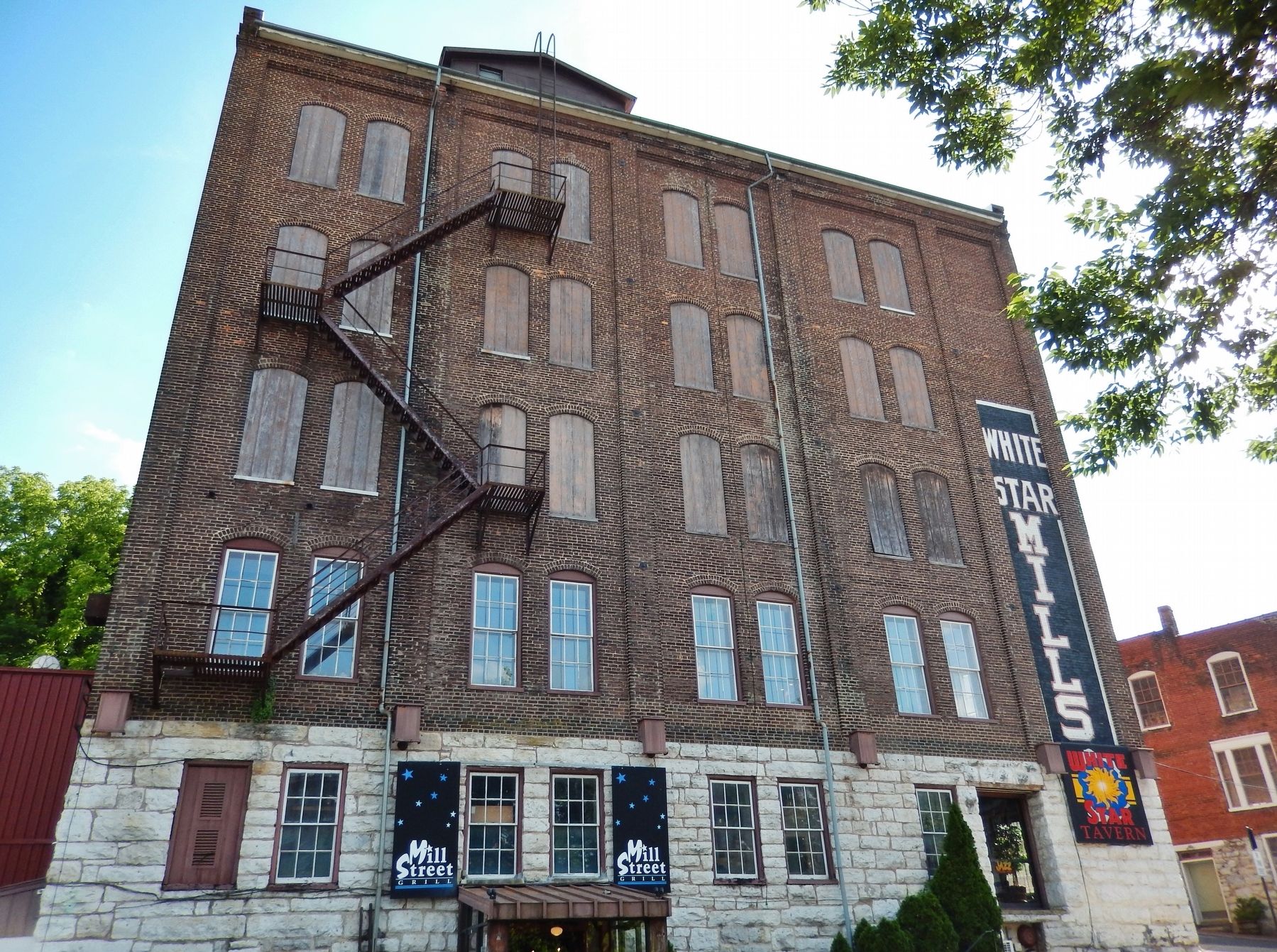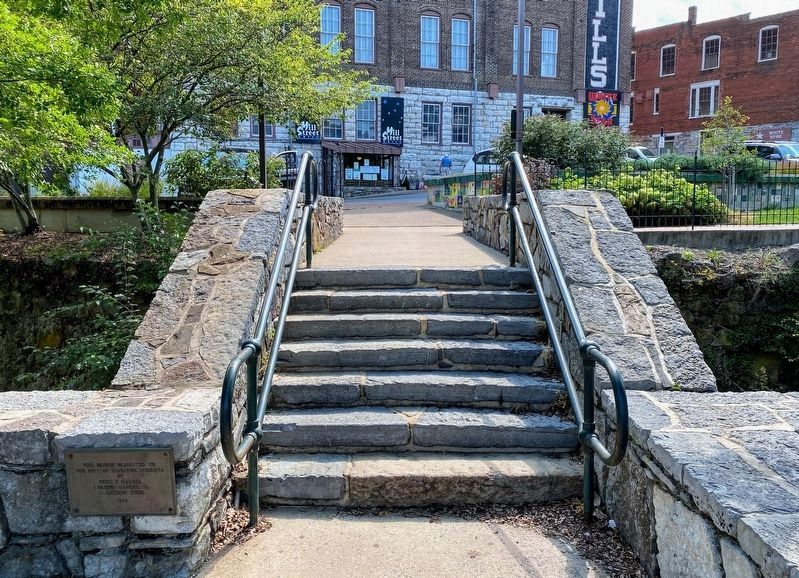Staunton, Virginia — The American South (Mid-Atlantic)
Lewis Creek Watershed
Who was John Lewis?
Lewis Creek takes its name from John Lewis (1678-1762), one of the most prominent of the earliest settlers in the upper Shenandoah Valley.
In the early 1730s, Lewis and his family, who emigrated from County Donegal, Ireland, established their home in Virginia. The Lewis family home, known at times as Bellefont and Fort Lewis, was located a mile east of what is today downtown Staunton near a spring and the creek that has historically borne his name.
During the 1730s, King George II of England granted William Beverley, a wealthy planter and merchant from Essex County, Virginia, over 118,000 acres. Beverley deeded a large tract of this land along the creek to Lewis.
In 1747, John Lewis' surveyor son, Thomas, laid out the town of Staunton, then known as Beverley's Mill Place. The town plat, which contained the Augusta County courthouse, was named to honor Lady Rebecca Staunton Gooch, the wife of Virginia Gov. William Gooch, who had encouraged settlement of the region. The grid pattern of streets remains the core of Staunton today.
In addition to Lewis Creek, as you drive Interstate 81, you may notice that portions of that highway are named for pioneer settler John Lewis and his son, Andrew. Andrew Lewis' skillful military leadership and bravery in the French and Indian War, Lord Dunmore's War, and the American Revolution, earned him a lasting place in the annals of Virginia history.
Mills on Lewis Creek
There were at least a dozen mills within five miles of the Augusta County Courthouse by 1775.
Early settlers harnessed the water power of the area's headwater streams and rivers to power multi-purpose mills that ground grains for flour and meal, pressed apples for cider, ground gypsum (land plaster) for fertilizer, sawed and planed wood, powered iron production, made paper, and carded wool. As one of the earliest industries in Augusta County, milling also powered the local economy.
While no mills along the banks of Lewis Creek' survive, historians have documented the approximate location of the following late-18th through late-19th-century mills:
Peaco's Mill Robertson Mill Witz and Holt J. F. Tannehill Mill
Some of these mills occupied the same site during different periods.
By the 1770s, Augusta County farmers had turned to wheat and corn as their major crops, thus spurring the proliferation of mills throughout the countryside. Throughout the 19th century, milling and the other grain-based industry, distilling, vied for top billing among county industries. Also, for much
of that century Richmond was the nation's milling capital. Improved transportation routes meant grain and flour could be transported by wagon to the James River and then sent by water to Richmond, and eventually around the world. Augusta County grain, as flour and whiskey, was a staple in California's gold camps.
By 1900, there were seven grain mills within the city of Staunton. One of these was White Star Mill (1892-1966), directly in front of you. Two of the partners in this new steam-powered mill were Charles Asbury Holt and Isaac Witz, who sold their Lewis Creek mill to invest in this new endeavor.
Civic Efforts to Protect Lewis Creek
Efforts continue to protect Lewis Creek. As a headwaters tributary to the Middle River, one of three rivers that arise in Augusta County and form the South Fork of the Shenandoah River, Lewis Creek is an important part of our regional watershed. In this location, plantings and permeable pavers help to slow down, filter, and absorb stormwater before it enters the creek.
The signs indicated on the map to the right include more details of Lewis Creek's history and importance.
Erected by The Augusta Garden Club.
Topics. This historical marker is listed in these topic lists: Agriculture • Colonial Era
• Industry & Commerce • Settlements & Settlers.
Location. 38° 8.88′ N, 79° 4.256′ W. Marker is in Staunton, Virginia. Marker can be reached from Mill Street south of Greenville Avenue (Business U.S. 250). Marker is located beside the walkway, overlooking the creek, near the parking lot between Greenville Avenue and Mill Street. Touch for map. Marker is at or near this postal address: 1 Mill Street, Staunton VA 24401, United States of America. Touch for directions.
Other nearby markers. At least 8 other markers are within walking distance of this marker. Dr. William Fleming (within shouting distance of this marker); Augusta County (about 400 feet away, measured in a direct line); Veterans Memorial (about 400 feet away); Korean and Viet Nam Memorial (about 400 feet away); Augusta County Courthouse (about 400 feet away); Augusta County World War I Memorial Tablet (about 500 feet away); Roll of Honor (about 500 feet away); Dr. Alexander Humphreys (about 500 feet away). Touch for a list and map of all markers in Staunton.
Also see . . .
1. John Gilbert Lewis. John was the first settler in the Shenandoah Valley, arriving there circa 1732. (Submitted on May 28, 2019, by Cosmos Mariner of Cape Canaveral, Florida.)
2. John Lewis: Patriarch. John Lewis' fame
would lie secure in his stature as the pioneer settler of Augusta County. But it has been doubly enhanced by the prominence of the scions he and Margaret Lynn produced. This book, along with listing more than 9,200 descendants of John and Margaret Lewis, down to the llth generation, devotes several well-researched and reasoned chapters to John Lewis, his wife and children. (Submitted on May 28, 2019, by Cosmos Mariner of Cape Canaveral, Florida.)
Credits. This page was last revised on August 27, 2021. It was originally submitted on May 27, 2019, by Cosmos Mariner of Cape Canaveral, Florida. This page has been viewed 1,040 times since then and 120 times this year. Photos: 1, 2. submitted on May 27, 2019, by Cosmos Mariner of Cape Canaveral, Florida. 3. submitted on May 28, 2019, by Cosmos Mariner of Cape Canaveral, Florida. 4. submitted on August 26, 2021, by Shane Oliver of Richmond, Virginia.



